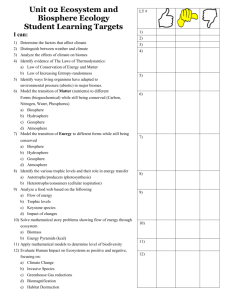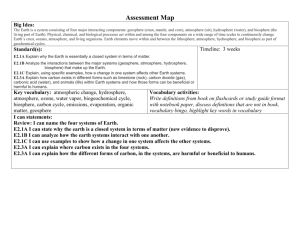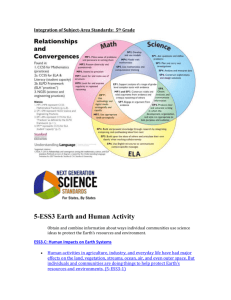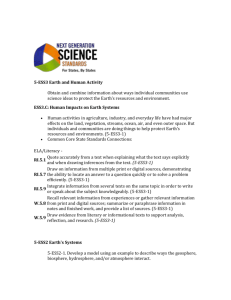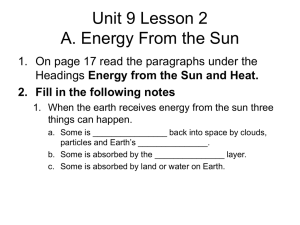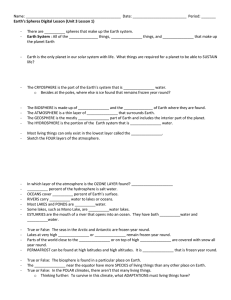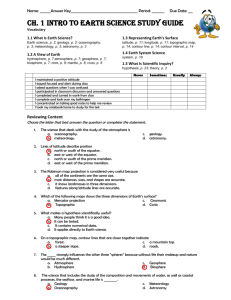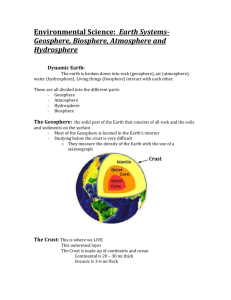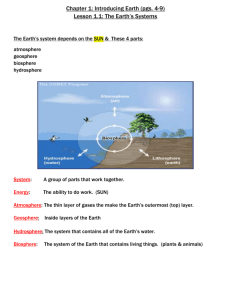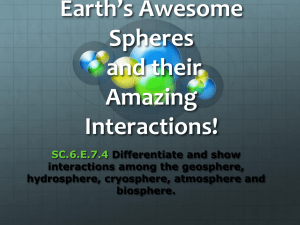Chapter 1 Test Review Notes
advertisement
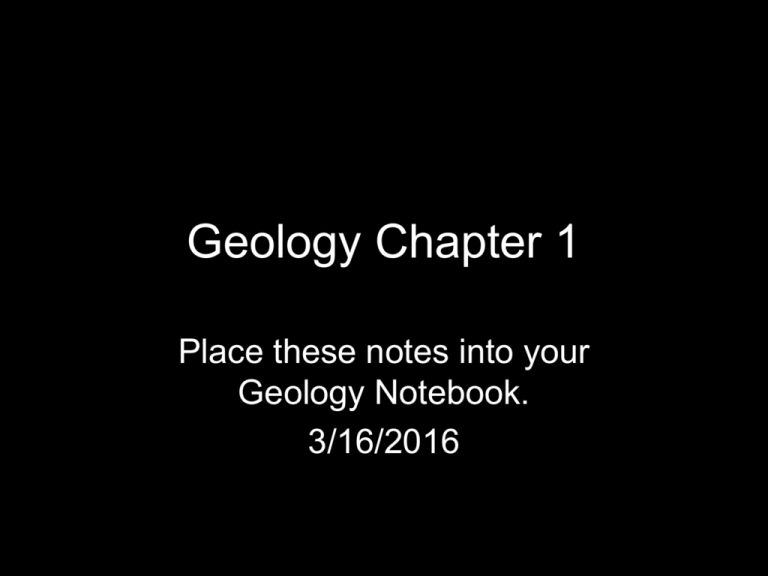
Geology Chapter 1 Place these notes into your Geology Notebook. 3/16/2016 Earth’s Four Spheres • • • • Biosphere Atmosphere Geosphere Hydrosphere Biosphere – All living things in and on the Earth. Atmosphere: Mixture of gases found in and that surround the Earth. Geosphere: Beaches, soils, rocks, mountains, crust, mantle and cores of the Earth. • Hydrosphere – Only three percent (3%) of the Earth is freshwater. 70% of that is frozen. The other 30% is groundwater, lakes, soil moisture, water vapor, or in bodies of water. • Humans (biosphere) built a dam out of rock materials (geosphere). • Water in the lake (hydrosphere) seeps into the cliff walls (geosphere), behind the dam, becoming groundwater (hydrosphere) or evaporating into the air (atmosphere). • Humans (biosphere) harness energy from the water (hydrosphere) by having it spin turbines (geosphere) to produce electricity. • Volcanoes (1) erupt, sending ash and gases into the air (2), and sending lava and ash down onto surrounding forests (3) and human habitations (4). • Plants (5) draw carbon dioxide from the air (6) and water from the hydrosphere (7); they release oxygen and water vapor, and then may be eaten by animals (8). • Hurricanes (9) sweep across the ocean (10) and onto the land (11) changing the dwellings of people (12) who live along the coast. • Human beings (13) drill wells into Earth’s crust (14) to draw out groundwater (15) for drinking and irrigation of crops (16). Albedo • The percentage of energy that is reflected without being changed as it reflects from the Earth’s surfaces. Density • Mass of an object divided by its volume. • D = m/V Volume • The amount of space occupied by a substance. Atmosphere • Gaseous envelope of air surrounding Earth. 78% nitrogen, 21% oxygen, 1% other gases. • One of the four spheres of Earth. Biosphere • All living organisms in the Earth system and their environments; one of the four spheres of the Earth System. Geosphere • Rocks, mountains, lithospheric plates, and other physical features of Earth, except for water. Hydrosphere • All water in the Earth system, gaseous, (water vapor) solid, (snow & ice) & liquid (rain and water). Carbon cycle • Biogeochemical circulation of carbon through the Earth system. System • A naturally occurring group of objects or phenomena that share matter and energy. Closed system • A system in which energy can enter or leave, but matter cannot. • Example: A sealed glass jar of tea. • Example: A deep-sea submersible that carries human researchers to great depths. Open system • A system in which there is a free exchange of both energy and matter between the system and its surroundings. • Example: An island; The island reflects sunlight (energy) back to the atmosphere The island may exchange sediment with the ocean when it rains. (matter) Cycle • The physical or chemical processing of Earth materials that repeats over time. • Examples: Water cycle, Carbon cycle, Rock cycle, and Energy cycle. Water Cycle Carbon Cycle Rock Cycle Energy Cycle Energy cycle • The movement of energy into and out of the Earth system. Geothermal energy • Heat energy that originates from within the Earth and drives the movements of Earth’s tectonic plates. Solar energy • Energy emitted by the Sun. Tidal energy • Energy created by gravitational pull of the sun and moon on Earth’s oceans. Model • A simplified representation of an object, process, or phenomenon, used as the basis for further study or investigation. A model is a representation of an object, process, or phenomenon. In a closed system, the only thing that can enter or leave is energy. A beaker of water is heated over a laboratory burner. This is an example of an open system. A test tube containing plant material and water is sealed and left in sunlight. This is an example of a closed system. One reason Earth is not entirely a closed system is because the atmosphere loses hydrogen to space. The gaseous envelope surrounding Earth is called the atmosphere. Most of Earth’s fresh water is locked up in glacial ice. You are considered to be part of Earth’s biosphere. The lava from a volcano destroying a nearby forest is an example of the geosphere interacting with the biosphere. A canyon that is formed when rocky ground is eroded by a river is an example of the hydrosphere interacting with the geosphere. Pollution from the chimney of a factory is an example of the biosphere interacting with the atmosphere. Most of Earth’s liquid form of water is in oceans. Phytoplankton play an important role in the carbon cycle because photosynthesis by phytoplankton removes carbon from the atmosphere. A sequence of events that repeats itself is known as a cycle. The carbon cycle is an example of a biogeochemical cycle. The process of water exiting a plant through its leaves is known as transpiration. Energy in a system cannot be completely recycled. Carbon can enter the atmosphere by forest fires, being breathed out by animals, and released in volcanic eruptions. The major source of Earth’s energy is solar energy. If the Earth took in more energy than it released the climate would get warmer. Give an example of how all four of Earth’s spheres can interact with each other. A human being (biosphere) drills an oil well (geosphere) to make fuel and oils for cars. Cars burn the fuel, releasing pollutants into the air (atmosphere) that contribute to smog, and a ship carrying the oil has an accident and spills it over the ocean (hydrosphere) killing many of the animals (biosphere) that live in that part of the ocean. Discuss different ways that people can affect Earth’s energy budget. Changing albedo by forest cutting, planting, building, paving; Increasing the amount of carbon dioxide in the air by burning fossil fuels which causes more energy to be trapped on Earth; reducing carbon dioxide by planting trees.

